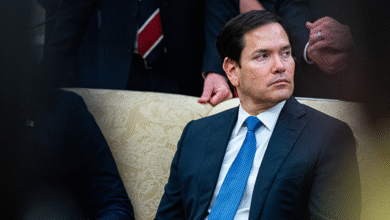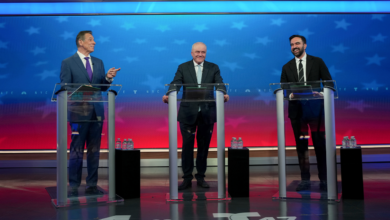Can Palestinians Trust Trump to Guarantee Gaza Deal With Israel?

The ceasefire reached in Egypt this week comes after two years of unprecedented bloodshed in the Israeli-Palestinian conflict – marked by levels of cruelty and violence that have shocked the conscience of the world. Although the terms of the agreement have not been fully disclosed, what has been noted – and what can be inferred from the context – raises serious doubts that the vague framework outlined in the twenty-point US “peace plan” being discussed will ever be fully materialized and implemented. At the heart of the fears lies not only the vast gap separating the positions of the two sides or the unequal power between them, but also the fact that almost everything depends on the guarantee of one man: US president Donald J. Trump.
Throughout previous ceasefire negotiations, Israel and Hamas remained far apart on many issues, including the timing and overall Israeli military withdrawal from Gaza, the disarmament of Hamas, and the nature and structure of future governance in the Strip.
The ceasefire reached in Egypt this week comes after two years of unprecedented bloodshed in the Israeli-Palestinian conflict – marked by levels of cruelty and violence that have shocked the conscience of the world. Although the terms of the agreement have not been fully disclosed, what has been noted – and what can be inferred from the context – raises serious doubts that the vague framework outlined in the twenty-point US “peace plan” being discussed will ever be fully materialized and implemented. At the heart of the fears lies not only the vast gap separating the positions of the two sides or the unequal power between them, but also the fact that almost everything depends on the guarantee of one man: US President Donald J. Trump.
Throughout previous ceasefire negotiations, Israel and Hamas remained far apart on many issues, including the timing and overall Israeli military withdrawal from Gaza, the disarmament of Hamas, and the nature and structure of future governance in the Strip.
In previous talks, including January this year, mediators have addressed the issue by proposing a phased implementation process in which sticking points are pushed to phases two and three while the two sides implement a gradual prisoner exchange and the introduction of humanitarian aid. However, this phased process allowed the stronger party, Israel, to violate the ceasefire at the end of the first phase with impunity, once it had recovered a large number of hostages but before it had to take steps to end the war and withdraw.
These dynamics are at play again. Despite the US President’s broader proposal, it is clear that negotiators in Egypt chose to reach a phased agreement – except this time, the remaining Israeli prisoners will be released all at once.
Key sticking points in the Trump plan have not been addressed, including the gaps between the version agreed to by eight Arab and Muslim countries on the sidelines of the UN General Assembly in September, and the one reviewed and accepted by Israeli Prime Minister Benjamin Netanyahu in Washington a few weeks later. This means that the remaining Israeli prisoners will be released without any guarantees that anything else will be completed.
Although it is positive that the people of Gaza will not have to wait long for some desperate relief, the sustainability of the ceasefire is questionable. Even if a broader agreement is reached one way or another, Netanyahu may decide somewhere in the implementation process that abandoning the deal is in his interests and either resume his military campaign or find another arrangement that suits his interests.
But behind all this there is a simple idea that makes even the structure of negotiations and phased implementation irrelevant: every concession made by Hamas is irreversible, while every concession made by Israel is reversible.
For example, if Israel withdraws its military forces from Gaza one day, they can enter again the next day; If it releases 1,000 Palestinian prisoners today, it can re-arrest them tomorrow. On the other hand, once Hamas frees the Israeli hostages, they are gone forever. If it decides to give up its weapons, a mechanism may be put in place to recover them if Israel backs out of the agreement, but it will face intense pressure to do so in practice.
For Hamas, this fundamental dilemma makes the guarantor of the agreement absolutely pivotal. Enter the less reliable Trump. Although Hamas officials recently claimed that the movement trusts the president to support the deal, this could not be further from the truth — and for good reason.
When Israel violated the January ceasefire in March, at the end of the first phase, it did so with Trump’s blessing. In fact, Trump undermined the deal midway through the primary by proposing to turn Gaza into a “Riviera” under US control and empty it of Palestinians — a ludicrous idea that made Palestinians seriously question his commitment to basic principles of legality, justice, and morality. Perhaps this improvised and ill-considered idea gave Netanyahu the political cover to abandon the second and third phases of the ceasefire and openly pursue the goal of ethnic cleansing in the Gaza Strip. In fact, every step of the way, Netanyahu and his cabinet ministers claimed that their actions were according to Trump’s plan.
Hence, Trump’s credibility has eroded. In June, he allowed Israel to carry out its surprise attack on Iran in the midst of nuclear negotiations between the United States and Iran, even claiming to have used a suspended round of talks as a smokescreen for Israel. Finally, Trump was implicated in the Israeli attack on Qatar in September, either because he allowed it to happen or failed to prevent it.
Ironically, it was this lightning decision by both Israel and the United States that most likely created the opportunity for the current ceasefire negotiations. Spurred by the attack, and recognizing the emerging threat to their security, Gulf states and other US allies in the region rallied around Qatar and presented a united front to Trump, demanding, among other things, that Israel be reined in and reengage in a plan to end the carnage and famine in Gaza.
As evidenced by Trump’s meeting with eight of these states in New York, from which Trump’s latest proposal was born, this appears to have had the desired effect. This time, Trump appears to be more personally involved than in the past, with his credibility with respected regional allies at stake. Also crucial is that these countries have demonstrated their ability to act as a counterweight to Israeli influence over the Trump administration, enhancing the possibility that Trump will put the required pressure on Netanyahu to make the negotiations successful. Whether this dynamic between Trump and the Arab countries will continue is an open question, but the emerging alliance between those Arab countries, Turkey, and Europe provides additional heft to their diplomatic efforts.
As negotiations continue, Hamas will have to make some decisions that will challenge the organization at its core. Its officials are likely to realize at this stage that they have reached the end of the road; No one will come to save the Palestinian people from the Israeli genocidal onslaught. Although momentum is building abroad, it is foolish to hold out hope that international sanctions and an arms embargo are imminent and will be enough to hold Netanyahu’s hand while he continues to receive American support.
Meanwhile, Hamas faces enormous pressure and isolation, even as sympathetic countries like Qatar and Turkey align itself with the position that it must disarm, and it has almost no cards except the hostages — all of whom will likely return to Israel by next week. But to what extent would Hamas go in giving up its terms of survival in order to ensure the survival of the Palestinian people in Gaza? To what extent will it give up its sacred principles, such as its right to bear arms and resist illegal occupation, until a solution to the Palestinian issue is reached?
There is also the issue of forging a larger political path to address Palestinian self-determination, which is important not only for the Palestinian side but also for all countries that will have a role in Gaza moving forward. Although this point was not addressed coherently in Netanyahu’s revised plan, no country wants to be involved in an endless role in governance and security in Gaza, especially while Israel continues to pursue its expansionist goals in the West Bank.
This fear is the reason behind some Arab and European countries’ renewed enthusiasm for diplomacy in seeking to achieve a two-state solution, and makes them more invested in ensuring the success of the agreement under negotiation and its eventual political solution. At the very least, they are strongly calling for the return of the Palestinian Authority to Gaza, which would partially relieve them of their direct intervention on the ground – although the Israelis are strongly opposed to this.
Whether Israel wants a broader agreement or not is an open question. The country is deeply isolated and losing friends quickly. The bigger issue is what will happen if Netanyahu decides to exit the deal once his goals are achieved. Will Trump use the leverage at his disposal over Israel to force it to comply?
Netanyahu has shown that he knows how to pick his battles with Trump, and when he is forced to concede, he outmaneuvers him over time. Since October 7, 2023, he has also found that waging a permanent, multi-front war is an ideal arena for navigating politics, like being Willy Wonka in his glass elevator, pressing buttons and pulling levers to go in any direction he wants.
If Netanyahu abandons the deal in full view of the world, there will likely be widespread backlash, with more countries signing up to take punitive measures against Israel. But experience indicates that only pressure from Trump will force him to do so, and this pressure is not guaranteed.
Don’t miss more hot News like this! Click here to discover the latest in Politics news!
2025-10-10 16:08:00




